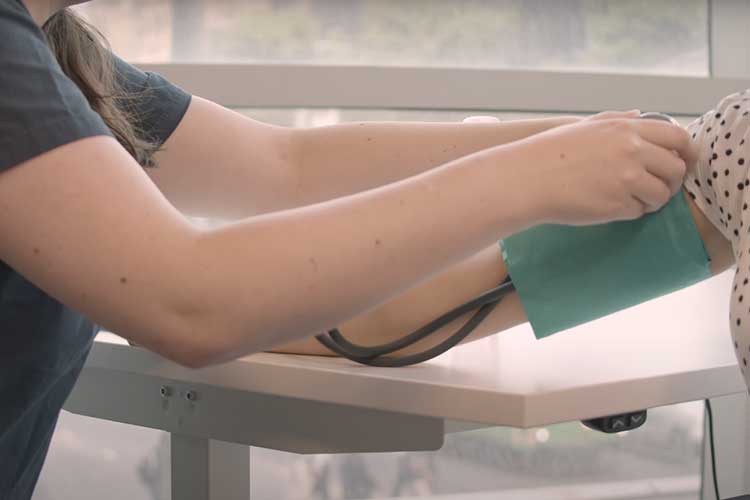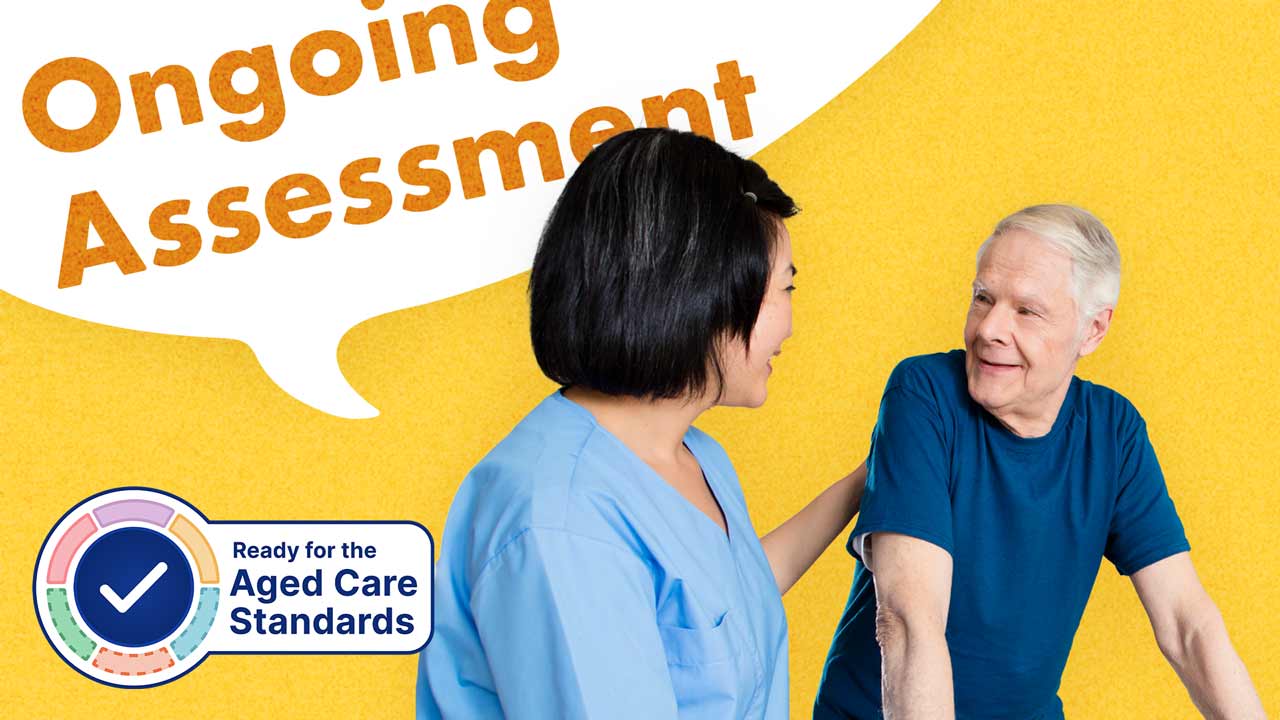Older people receiving aged care services typically do so for a length of time in which their health status may change or deteriorate.
In order for aged care providers to adjust to these changes and ensure older people are receiving an appropriate level of care, regular re-assessment of their condition, needs and goals is essential.
Ongoing Assessment Under the Strengthened Aged Care Quality Standards
Standard 3: Care and Services - Outcome 3.1: Assessment and Planning of the strengthened Aged Care Quality Standards (Action 3.1.2) requires aged care providers to partner with older people and communicate with them on an ongoing basis in order to perform assessments and plan their care and services (ACQSC 2024).
Additionally, Action 3.1.5 requires care and services plans to be regularly reviewed. This includes when:
- The person’s needs, goals or preferences change, or their current plan is ineffective
- There is a change or decline in the person’s mental health, cognitive or physical function, capacity, condition or ability to perform activities of daily living
- There is a change in the care being provided by the person’s family or carers
- A transition of care occurs
- News risks arise, or the person experiences a change or incident that impacts them
- There is a change in the other people who are responsible for the person’s care.
(ACQSC 2024)
Initial Assessment
Upon the commencement of a person’s care, providers should undertake an initial assessment in order to identify their needs and gain baseline data for the person.
The goal of assessment is to gain a multi-dimensional understanding of the person by exploring their medical, physiological, social and psychological functioning. By taking the time to thoroughly examine each aspect of their life, you will be able to identify any issues, minimise risks and maximise their quality of life (Health.vic 2015).
The Victorian Department of Health has developed a template for conducting a comprehensive assessment of older people in health and aged care. This assessment includes:
- Advance care planning
- Medical history
- The person’s goals
- Medications
- Lifestyle (e.g. smoking, alcohol, sleep)
- Immunisation status
- Vital signs
- Pain
- Neurological/cognitive function
- Sensory function
- Physical function
- Cardiovascular system
- Respiratory system
- Gastrointestinal system
- Oral health
- Abdominal function
- Dietary requirements
- Skin condition
- Continence status
- Musculoskeletal condition
- Personal information (e.g. background, family, education, work, culture, religion)
- Sexuality and gender identity.
(Health.vic 2014)

Each one of these assessments should be performed comprehensively. Further risk screening and assessment may also be completed during the initial assessment, such as a falls risk, malnutrition risk and pressure injury risk assessment. It’s important that each of these areas are also part of the ongoing assessment with the person.
Ongoing Assessment
Once care has commenced, the client should continue to be assessed on a regular basis in order to identify any changes in their condition, needs and goals.
Ongoing Care Discussions
Aged care providers should have regular conversations with older people in order to determine the appropriate level of care required for each individual. The goal of these discussions is to:
- Help the provider effectively manage the person’s care
- Ensure the care and services being provided are meeting the person’s needs.
(DoHaAC 2020)
The following topics should be discussed in these conversations:
- The person’s resident agreement
- The person’s accommodation agreement
- The person’s extra services agreement (if needed)
- The safety and effectiveness of the care services being provided
- Any risks to the person’s health and wellbeing
- The person’s needs, goals and preferences (including advanced end-of-life planning, if they wish).
(DoHaAC 2020)
The results of these discussions should be documented in the person’s agreements (DoHaAC 2020).
Documentation
Your organisation may use some of the following documentation in order to maintain information about older people and their needs:
- Lifestyle profile: Includes the necessary information to develop a comprehensive care plan for the person, including their history, background, likes/dislikes, hobbies etc.
- Abilities assessment form
- Unmet need/intervention/strategies form
- Attendance form
- Participation form: Documents the activities a person has participated in and the level at which they participated.
(Quality Aging n.d.)
Your facility may utilise a ‘resident of the day’ program to assess whether each person’s needs are being appropriately met. Generally, each person would be reviewed at least every month (Quality Aging n.d.).
When conducting a reassessment, you may notice that the person is eligible for additional funding under the Australian National Aged Care Classification (AN-ACC).

Conducting an Assessment Effectively
When assessing an older person’s needs, it is important to keep the following in mind:
- Understand the person’s perspective
- Consider that older people may require more time and breaks when completing formal assessments
- Ensure the person’s communication needs are being met and they are provided with assistance if required (e.g. interpreters, hearing aids)
- Do not assume the person knows why they are being assessed - explain why certain tests are being undertaken or certain questions asked
- Establish the person’s cognitive status as soon as possible so that the assessment can be conducted accordingly
- Be aware of depressive symptoms (e.g. minimal eye contact, non-committal responses) Consider any cultural differences and provide support (e.g. cultural liaison officers, Aboriginal and/or Torres Strait Islander health workers) if required
- Build rapport with the person.
(Health.vic 2015)
Applying Clinical Skills
When conducting assessments, it’s important to consider the elements of effective clinical decision-making:
- Considering the person’s situation
- Using observation and questions to gather information and cues
- Processing the information (what does it mean?)
- Identifying problems and issues (what does the information suggest?)
- Establishing goals and deciding what actions should be taken
- Taking actions
- Evaluating outcomes
- Reflecting on the process.
(Health.vic 2014)
Therapeutic Communication
Therapeutic communication involves prioritising the person’s wellbeing by providing them with support and information while maintaining professional distance and objectivity. It comprises a range of techniques, including:
- Deliberate silence, which gives both parties an opportunity to process the conversation
- Acceptance (affirming that you are acknowledging what the person has to say)
- Recognising the person’s behaviour rather than complimenting (which may come across as condescending)
- Offering time and attention
- Giving broad conversation openings (e.g. ‘What’s on your mind today?’)
- Active listening
- Asking for clarification if the person says something ambiguous or unclear
- Placing events in time in order to gain a clearer understanding of the whole picture (e.g. asking when something happened)
- Making observations that may help elicit explanations or information from the person (e.g. ‘You look tired’)
- Encouraging the person to describe their perceptions
- Summarising what the person has told you and checking to ensure you have understood them correctly
- Encouraging the person to reflect (which may help them think of solutions on their own)
- Focusing on certain topics or statements, encouraging the person to discuss them further
- Confronting (disagreeing, challenging assumptions or presenting reality) can be helpful if used correctly, and once trust has been established with the person
- Voicing doubt
- Offering hope and humour.
(Rivier University 2017)

Person-Centred Care
Practising person-centred care is a key component of the assessment process, as older people should be empowered to actively participate in future planning and decision-making. Older people should be provided with adequate information and opportunities to ask questions so that they can make informed decisions about the direction of their care. Utilising person-centred care improves care recipient satisfaction and the quality of the services delivered (ACSQHC 2019; Better Health Channel 2015).
Conclusion
The ongoing assessment of older people’s needs is an essential component of care. In order to provide an appropriate level of care, it is important for aged care providers to work closely with older people to regularly discuss and evaluate whether the services being provided are adequate.
Test Your Knowledge
Question 1 of 3
Which one of the following is included in the comprehensive assessment template for older people developed by the Victorian Department of Health?
Topics
References
- Aged Care Quality and Safety Commission 2024, Standard 3: Care and Services, Australian Government, viewed 22 April 2024, https://www.health.gov.au/resources/publications/strengthened-aged-care-quality-standards-august-2025?language=en
- Australian Commission on Safety and Quality in Health Care 2019, Person-centred Care, Australian Government, viewed 26 June 2023, https://www.safetyandquality.gov.au/our-work/partnering-consumers/person-centred-care
- Better Health Channel 2015, Patient-centred Care Explained, Victoria State Government, viewed 26 June 2023, https://www.betterhealth.vic.gov.au/health/ServicesAndSupport/patient-centred-care-explained
- Department of Health and Aged Care 2020, Ongoing Care Discussions for Residential Aged Care, Australian Government, viewed 26 June 2023, https://www.health.gov.au/initiatives-and-programs/residential-aged-care/managing-residential-aged-care-services/ongoing-care-discussions-for-residential-aged-care
- Health.vic 2015, Assessment Process, Victoria State Government, viewed 26 June 2023, https://www2.health.vic.gov.au/hospitals-and-health-services/patient-care/older-people/comm-topics/assessment/assessment-process
- Health.vic 2014, Comprehensive Health Assessment of the Older Person in Health and Aged Care Assessment Template, Victoria Government, viewed 26 June 2023, https://www.health.vic.gov.au/residential-aged-care/comprehensive-health-assessment-of-the-older-person
- Quality Aging n.d., Resident Documentation, Quality Aging, viewed 23 June 2026, https://www.qualityaging.com.au/Downloads/Resources/Documentation/Resident-Documentation.aspx
- Rivier University 2017, 17 Therapeutic Communication Techniques, Rivier University, viewed 26 June 2023, https://www.rivier.edu/academics/blog-posts/17-therapeutic-communication-techniques/
 New
New 
